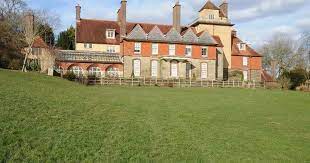This month, we look at the history of some more lost country houses collected by Matthew Beckett, a “frustrated builder” with a passion for architecture who was inspired to compile a website that would memorialise all of England’s vanished grand houses.
“It’s just a hobby for me,” he explains. “Through this study, I will be able to indulge my passion for architecture. After seeing the ruined shell of Guys Cliffe House in Warwickshire about eight years ago, my curiosity was piqued. The website started as a place for me to share the results of my study, including a list of the houses and photographs of them, as well as comprehensive histories. It has gotten a lot of attention, with about 12,000 visitors every month.”
Sussex’s lost houses are described by Mr Beckett as “a fascinating cross-section of properties, ranging from the aristocratic to the imaginative.”
Lady Holt is a fictional character who appears in the novel
Lady Holt at Harting, formerly the house of the Carylls, a wealthy and influential Sussex family who made their fortune in the iron industry, is one of them. It is thought to have been founded in 1689 by Lord Caryll and passed down through the family generations until it gained notoriety in 1747 when the infamous Hawkhurst band of smugglers committed one of two murders there. The assassinations were so violent that they shocked the public and changed the public perception of smugglers.
Lady Holt was sold by the Caryll family to the Duke of Richmond in 1766-7, and it was finally demolished by 1770. The estate of Lady Holt Park is now managed by the Forestry Commission.
Beedingwood House was designed in 1876 for an Irish bacon merchant in Colgate, near Horsham.
With its flora and fauna stonework columns, a corner turret, circular rooms with conical roofs, and high-level bulls-eye windows, it was a fabulous example of Victorian architectural exuberance.
Hill’s Place in Horsham was originally a timber-framed house with a later addition of a new range with a five-bay frontage and three-story frontage with polygonal bay windows, tall chimneys, and Dutch gables.
Housing has been built on the site.
Wych Cross Place is a location in Wych Cross that is located
The history of the original Wych Cross Place at Forest Row, as well as the circumstances surrounding its removal, remain unknown. It was owned by Douglas W Freshfield, a mountaineer, author, and lawyer whose family firm Freshfields is now Freshfields Bruckhaus Deringer, the world’s second-largest law firm, from the late nineteenth century.
Freshfield, his wife, and their five children resided at Wych Cross Place. When their 14-year-old son died tragically at the age of 14, they gave Forest Row a building to use as a parochial hall and institute, but Freshfield Hall burned down the day after the boy’s funeral.
The new structure still stands today
The Emir of Sharjah’s 24-year-old son died of a heroin overdose in that city in 1999. The estate and house are now occupied by private individuals.
Searles was a Victorian Gothic mansion in Fletching built about 1865 and was the first house in Sussex to have electric light. It was the home of Sir Thomas Maryon Wilson, a baronet of Eastbourne, who served as the High Sheriff of Sussex. The house was destroyed during WWII when it was used as a Canadian officers’ mess, and it was abandoned after the war. The only remaining remains of this grand mansion are the Grade II listed North Lodge and the South Lodge, which were demolished in 1949.
The Wadhurst Estate is located in Sussex, England.
Tetra Pak is the heir to the Tetra Pak business. Hans Rausing, a Swedish businessman and one of the world’s wealthiest citizens, purchased the Wadhurst Estate in Wadhurst in 1976 and replaced the original Wadhurst Hall with an ultra-modern one-story structure. After being dilapidated during the Second World War, when it was occupied by Canadian troops and later used as a prisoner-of-war camp, the hall was demolished in 1948.
After the demolition, some parts of the hall were left intact, which Rausing retained as a feature of the gardens. Knepp Castle, near Shipley, is interesting because it is the site of two former buildings that have been destroyed. All that remains of a once-important castle dating back to the early 1200s is a ruined tower that “stands on a mound like a broken tooth.” William de Braose, Lord of the Rape of Bramber and one of King John’s most trusted barons owned the land.
As England’s barons revolted against the king over the expense of his military operations in France, William fell out of favor. William’s wife and heir were imprisoned and starved to death by King John, who also forced William into exile in France. He ordered the demolition of Knepp Castle in 1215.
The Royal Pavilion in Brighton and Buckingham Palace were both designed by John Nash, who is also known for his work on the Royal Pavilion in Brighton and Buckingham Palace. Sir Charles Merrick Burrell, the Conservative MP for New Shoreham for 56 years and later Baronet Raymond of Valentine House, designed it in the late nineteenth century. Unfortunately, it was destroyed by a massive fire in 1904, and Knepp Castle was built in its place.
Author Bio:
A merchant company content researcher wrote this article. It is a merchant production company and an Estate marketing agency headquartered in the United Kingdom that serves clients all over the world.
